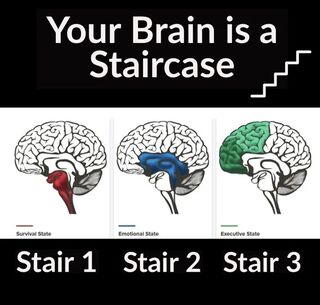Trauma
How Bottom-Up Treatment Can Address Trauma
Strategies to help the adult brain engage with past trauma.
Posted December 19, 2021 Reviewed by Gary Drevitch

Picture your brain as a staircase. Each step is a stage of physical brain development which starts in the womb and ends, on a physical level, around age 25. Each stair step going up is an advanced stage of development.
Talk therapy doesn’t always work in treating trauma. Why? It’s a top-down treatment approach that typically targets the top step of your brain in order to access your lower steps. Talk therapy is like walking down your brain’s staircase. What if you walked up that staircase instead?
1st Stair: The brainstem (the “reptilian” brain) is the oldest part of your brain. It’s responsible for most of your automatic functions, such as your heart rate, body temperature, and blood pressure. In addition, your brainstem coordinates movement, controls arousal, and processes sensory information. Imagine a toddler sitting on the 1st step: This is your brainstem.
2nd Stair: The limbic system (the “emotional brain”) is known for its link to emotional experiences and regulation. It’s also responsible for motivation and storing explicit memories. Imagine an emotional teenager who’s desperately trying to figure it all out standing on the 2nd stair: This your limbic system.
3rd Stair: The cortex is the youngest part of your brain and often perceived as the smartest. It’s responsible for attention, perception, awareness, thought, memory, language, judgment, and consciousness. Imagine a 40-year-old adult who's great at “adulting” standing on the 3rd stair: This is your cortex.
Trauma Impacts Your Lower Steps
Have you experienced thoughts, behaviors, or emotions that you cannot change through logical thought or behavioral action plans? This might be because trauma, especially from experiences which occurred prior to age 25, impacts the lower stairsteps of your brain. Trying to utilize your rational brain (the 3rd stair) might not impact trauma, which is located in the 1st or 2nd steps of the staircase. Imagine an adult standing on the 3rd stairstep who is trying to convince the toddler on the 1st step to calm down. It doesn’t always work.
Here are a couple of cases:
Andre believes that he’s not good enough. He adopted this belief as a teenager as a result of years of emotional abuse and neglect. At 36, Andre excessively invests himself in his relationships and job in an attempt to prove that he is good enough. It has never worked because, no matter what he does, he cannot prove to himself that he is “good enough." Andre logically knows (at the level of the 3rd step) that he is good enough, but he cannot shake the belief (at the level of the 1st or 2nd step) that he’s not good enough, which causes him to feel anxious and depressed. This belief is stuck on the 1st/2nd stairs and is not reachable from the 3rd stair.
Andre cannot reach his 1st/2nd stairs where the injured teenager stands, believing that he isn't good enough.
Maria hoards food in order to prevent starvation. She hides food in her desk at work, in her closets, and in her vehicle. When she was 5 years old, her caregivers did not provide her with consistent meals, and she prepared her own food until she was 7. Maria has a substantial financial safety net, and she knows, at the 3rd stair level, that the likelihood that she will starve is nearly nonexistent, but she continues to hoard food in order to calm her anxiety, which is rooted at the level of the 1st stair.
Maria cannot convince herself that she won’t starve, as the starving child is standing on her 1st stairstep.
Andre and Maria are experiencing trauma that impacts their lower stairsteps. They each participated in talk therapy in which they addressed their 3rd stairsteps, and received some benefit from it, such as an awareness of their thought and behavioral patterns. Talk therapy is a top-down trauma treatment approach that targets the 3rd, and sometimes 2nd, stairsteps of the brain in order to access the lower stairs. Such approaches focus on changing your thoughts, perceptions, and cognitive experiences (3rd stair) in order to positively impact your emotional and bodily experiences (1st and 2nd stairs). Such top-down approaches—Cognitive Behavioral Therapy (CBT), Rational Emotive Behavioral Therapy (REBT), and Psychodynamic Therapy, for example—can be beneficial in treating trauma, but many clients benefit from both top-down and bottom-up treatment.
Bottom-Up Approaches Focus on Your Lower Stairsteps
Bottom-up approaches seek to access and heal trauma on the lower stairsteps, where it lives and thrives. Simply put, walking up the brain’s stairs instead of down allows you to address the impacts of trauma at their source. To better understand bottom-up approaches, consider Maria and Andre’s treatment.
Maria participated in top-down talk therapy for years. Imagine an adult standing on a 3rd stairstep trying to convince a toddler sitting on the first that she is not going to starve. The adult pleas, argues, and debates with a toddler who is virtually inaccessible and not even able to cognitively participate in the process. That’s top-down therapy, and for Maria, it didn’t help her to stop hoarding food. Maria then participated in bottom-up treatment approaches. The toddler, who had for years been ignored, was seen, understood, accepted, and provided with its basic needs. Imagine that the toddler is able to develop and walk up the stairs to adult Maria, who's waiting to provide comfort, nutrition, and parenting. This is what therapy was like for Maria and over a period of several months she was no longer hoarding food.
Andre could not convince himself that he was good enough, so he stopped trying. Instead, he participated in bottom-up interventions in order to address his trauma. He accessed the teenager sitting on his second stair. This teen didn’t need to be told that he was good enough because he would never believe it; rather, he needed to be shown. Andre was able to meet this teenager on the 2nd stairstep and show him that he is good enough. This teenager decided to walk up one stairstep in order to stay with adult Andre, who took on the role of a big brother and provided the teen with protection, acceptance, and reassurance. Andre slowly started to believe that he was good enough, without working himself to death or sacrificing everything for others.
Bottom-Up Treatment Methods
Interested in bottom-up therapy? Here are some common approaches:
- Eye Movement Desensitization and Reprocessing (EMDR) therapy utilizes bilateral stimulation to access and heal your lower stairsteps.
- Somatic Experiencing focuses on your body as a method to heal trauma.
- Internal Family Systems promotes healing by accessing and healing your inner parts.
- Expressive Arts Therapy applies art forms in an integrated fashion to heal trauma.
You Don’t Have to Choose
There are many reasons why you may not want to participate in bottom-up treatment approaches. Here are a few:
- You are participating in talk therapy, and you do not wish to stop.
- You like your therapist, and don’t want to stop seeing them.
- You need the support of your established therapist as you address your trauma with bottom-up approaches.
You can participate in both approaches; you don’t have to choose. There are therapists who provide both approaches, and you can see two therapists. I have many clients who see a talk therapist and also see me for bottom-up approaches to address their trauma. They have told me that they feel like they have the best of both worlds.
To find a therapist, visit the Psychology Today Therapy Directory.




